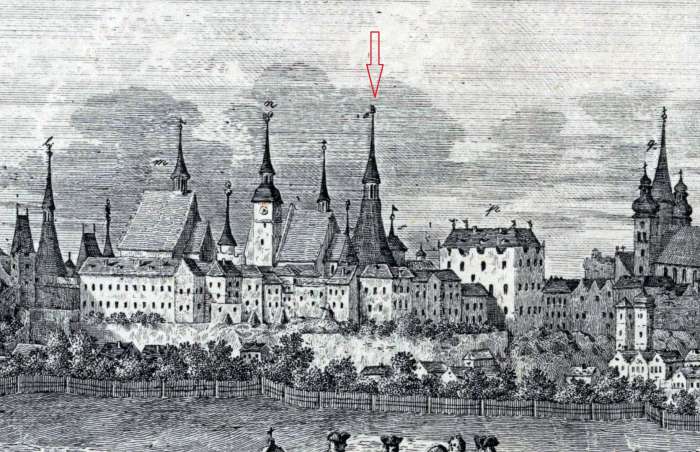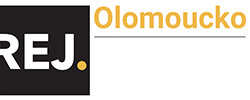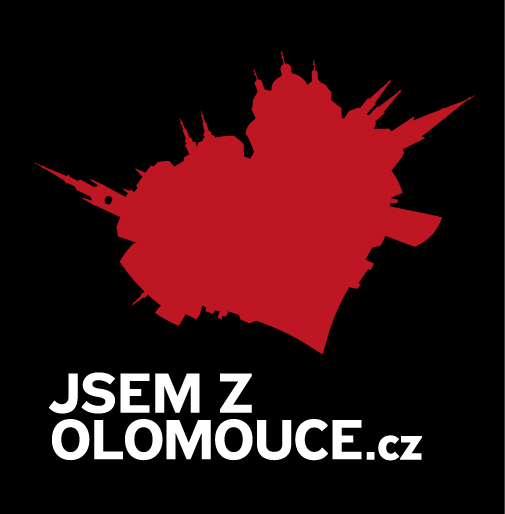
Na jižním okraji Předhradí, na tzv. Petrském návrší, stával starobylý kostel sv. Petra a Pavla. Tento kostel byl následovníkem nejstaršího chrámu v Olomouci, který údajně vysvětil samotný svatý Cyril v roce 863 a kníže Svatopluk ho v roce 885 zajistil příjmy, toto jsou ale informace založené jen na falzech. První ověřenou informaci o tomto kostele máme z listiny z roku 1063, kdy se stal kostelem biskupským při založení olomouckého biskupství a stal se "matkou všech kostelů té provincie". Jako sídelní kostel biskupů sloužil kostel sv. Petra až do roku 1141, kdy biskup Jindřich Zdík přenesl své sídlo k nově vybudovanému kostelu sv. Václava na Václavském návrší, který dnes známe jako Dóm.
Historie a zánik kostela a kláštera
Po nějakou dobu o kostele písemné prameny mlčí, další zpráva je až z roku 1207, kdy biskup Robert uvažoval o návratu biskupství ke sv. Petru. K tomu nedošlo, ale při kostele sv. Petra založil biskup Robert ženský klášter řehole sv. Augustina (před rokem 1213). Až do 70. let 13. století je tento klášter nazýván "u sv. Petra". Ještě během 13. století (kolem roku 1272) se augustiniánky osamostatnily a zbudovaly si zde klášter s kostelem sv. Jakuba. Klášter byl nadále označován podle tohoto chrámu. Nejpozději v této době se stal kostel sv. Petra kostelem farním. Mezi lety 1400 až 1455 jsou zaznamenány četné nadace k oltářům v kostele sv. Petra (oltáře Navštívení Panny Marie; sv. Kateřiny; Svatého Kříže; Božího Těla; Nanebevzetí a Zvěstování Panny Marie a Těla Kristova, sv. Martina, Svaté Trojice a sv. Jakuba Většího). Roku 1455 postihl kostel sv. Petra veliký požár, po kterém byl goticky přestavěn. Další velký požár svatopetrský kostel postihl v roce 1541.
Na počátku 16. století byl klášter sv. Jakuba určitou dobu opuštěný, později do něho přesídlili minorité, kteří ho drželi až do svého zrušení za josefínských reforem. V sekularizovaném objektu byla zřízena státní nemocnice, která trvala do roku 1896. Starou nemocnici pak koupilo město, nechalo ji zbořit a v letech 1901-1902 postavit tzv. Elisabethinum, což byl vzdělávací ústav pro výchovu budoucích učitelek. Ústav se skládal ze tří budov rozmístěných v areálu kostela sv. Petra a kostela sv. Jakuba. Školní budova se nacházela v místě zbořeného svatopetrského kostela a pensionát na místě dřívější nemocnice. Obě budovy byly propojeny třetím velkým objektem. O poměrně velké stavební akci se ale mnoho zpráv nedochovalo. Je zřejmé, že ačkoliv se vědělo, že se bude stavět v prostoru s bohatou historií, přístup byl čistě pragmatický; žádný respekt k minulosti a ani nejmenší průzkum nebo snaha zachovat něco z případných nálezů. Jediným zdrojem informací o rychle provedené stavbě je úřední referát v městské ročence (anonym 1900–1901), který se stručně zmiňuje o pozoruhodnějších nálezech zaznamenaných na schematickém plánku.
Kostel sv. Petra a Pavla měl až do josefínských reforem postavení hlavního kostela. V roce 1785 byl ale odsvěcen a v roce 1792, aniž by byl pořízen sebemenší popis nebo nákres, bezohledně zbořen. Podle dochovaných zobrazení víme, že to byla podélně orientovaná stavba s opěrnými pilíři, s polygonálně uzavřeným presbytářem. Měl jeden boční vchod od severu a hlavní vchod na západní straně. Při západním průčelí byla situována vysoká věž. Ta byla v 80. letech 17. století zbořena a na severní straně kostela byla přistavěna věž nová. Podle historických plánů k jižní straně kostela sv. Petra přiléhala menší stavba s polokruhovým závěrem. Jednalo se o kapli svatých Šebestiána a Rocha, o níž jsou záznamy v matrice svatopetrské farnosti ze 17. a 18. století. V této kapli byla krypta, ve které se našly pozůstatky farníků. Starý hřbitov byl také kolem kostela sv. Petra a pohřbívalo se i u svatojakubského kláštera. Po zrušení byl nový hřbitov zřízen za Hradskou bránou, v blízkosti zájezdního hostince Na Špici. Ke kostelu a klášteru náležel také nejstarší olomoucký vodní mlýn, o kterém je první zmínka z roku 1213. Ten stával pod hradbami na nedalekém Mlýnském potoce a říkalo se mu Jakubský nebo Petrský podle toho, kdo ho zrovna vlastnil. Mlýn byl zbořen po ničivém požáru v roce 1909.
Vzácné objevy při archeologických průzkumech
Při stavbě německé dívčí školy a ženského učitelského ústavu Elisabethinum (nyní budova Filosofické fakulty UP na Křížkovského 10) byla odkryta značná část půdorysu goticky přestavěného kostela sv. Petra s presbytářem, s jižní zdí prolomenou už dříve při kladení potrubního vedení a se základovým zdivem věže přiložené k severní stěně. Na severní straně presbytáře byly zjištěny základy tří opěrných pilířů a v každém z nich schránka a v ní olověná plaketa se symbolem evangelisty (anděl, orel, býk). Čtvrtou plaketu se přes usilovné hledání nepodařilo najít. Přišlo se na ni náhodou až v roce 1958 při pořádání numismatických sbírek ve Vlastivědném muzeu, kam se neznámým způsobem dostala někdy ve 20. letech minulého století. Při stavbě se našly pozůstatky kláštera s kostelem sv. Jakuba. Nálezová situace při stavbě Elisabethina se až na některé detaily shodovala s půdorysem, jak ho zaznamenal v osmdesátých letech 19. století W. Müller, ačkoliv v jeho době kostel sv. Petra už neexistoval. Otázka, kde uvedený autor čerpal informace, zůstává tedy otevřená.
Na počátku 20. století bylo také zaregistrováno několik archeologických nálezů (pravěké pohřebiště s kamenným obložením, kamenná sekerka, střepy, zvířecí kosti a parohy) a uprostřed dvora silná vrstva kostí. Zajímavá je zmínka o nálezu dvou zlatých mincí a několika stříbrných mincí i hracích žetonů. Mince nejsou určeny ani popsány a není uvedeno, zda byly v nějakém vztahu k nalezeným kostem. V každém případě jde o pozoruhodné nálezy vzhledem k tomu, že kolem kostela sv. Petra byl hřbitov a že není vyloučeno, že zvlášť stříbrné mince by se v některých hrobech z 11. století mohly objevit. Průzkumu se dávno poničená lokalita dočkala až v roce 1948. Na nádvoří Filosofické fakulty tehdy provedl pražský archeologický ústav plošný odkryv. Znovu byl odkryt presbytář a část lodi goticky přestavěného svatopetrského kostela. Bylo zjištěno, že presbytář měl dvě klenební pole a loď s čtverhrannými dlaždicemi, byla v něm renesanční krypta a ke středu západní obvodové zdi zvenku přiléhal čtvercový blok zdiva, který byl vyložen jako základna hranolové věže. Severní část kostelního půdorysu, kde se podle staršího výkladu nacházela věž, zasahující pod budovu fakulty, zkoumaná nebyla. Našlo se také několik hrobů bez milodarů, datovaných do 17. století a považovaných za pozůstatek hřbitova založeného až po zrušení kostela.
Nové nálezy z posledních let
V letech 2015 až 2017 probíhal záchranný archeologický výzkum při rekonstrukci děkanátu Filozofické fakulty Univerzity Palackého. Během výzkumu byla, kromě jiných mimořádných nálezů například z období raného středověku, prozkoumána také část hřbitova. Samotný hřbitov byl zrušen už roku 1784, nicméně nejstarší hroby pochází z průběhu vrcholného středověku. Výzkum odkryl celkem 98 hrobů na současném nádvoří děkanátu, dalších 486 hrobů bylo prozkoumáno v nově budovaném suterénu pod severním křídlem budovy. Jedná se tak o největší archeologicky zkoumaný hřbitov v intravilánu města na střední Moravě. V některých hrobech byly nalezeny součásti oděvu nebo pohřebního rubáše, jako spínadla, knoflíky, opaskové přezky nebo čelenky; zejména v barokních hrobech pak byly také četné milodary – křížky, růžence, medailony, či škapulíře. Velmi zajímavý je objev jámy zasekané 1,2 metru do skály, v jejímž zásypu se ukrývala keramika z doby kolem poloviny desátého století, železná sekerovitá hřivna o délce 47 centimetrů a naprosto unikátní břidlicová destička centimetr silná a přibližně jedenáct krát dvanáct centimetrů velká s rytinou mužské postavy nesoucí kříž. Traseologický posudek doc. Miroslava Králíka z Přírodovědecké fakulty Masarykovy univerzity v Brně potvrdil, že rýhy jsou pokryty sintrem, a zjistil velmi mnoho detailů týkajících se způsobu rytí.
V současné době také probíhá antropologická analýza kosterních pozůstatků, kterou provádí dr. Lukáš Šín z Archeologického centra Olomouc. Analýza sice ještě není u konce, ale v průběhu přináší zajímavá zjištění, jako např. doklady různých chorob našich předků. Příkladem je nález hrobu H210 se značně deformovanými kostmi. Jak ukázala analýza, šlo o jedince nakaženého syfilidou, která se pandemicky začala šířit Evropou koncem 15. století. Touto infekcí byla zasažena téměř celá část dochovaného skeletu horních a dolních končetin spolu se žebry, a to v podobě masivní chronické periostitidy, tzn. zánětu povrchových obalů kosti – okostice. Zánět způsobil nejen zbytnění kostí, ale především značné bolesti postiženému jedinci. Syfilida se projevuje na kostře v konečném stádiu nemoci (zhruba po 15 až 20 letech po vstupu infekce do těla), této fáze se pak velká část nakažených nedožila ani ve stoletích pozdějších. Zjištění projevů syfilitické infekce na skeletu z hrobu H210 tedy představuje ojedinělý nález.
Po ukončení výzkumu a rekonstrukce budovy byl v dlažbě nádvoří Filosofické fakulty UP na Křížkovského 10 vyznačen půdorys gotického kostela sv. Petra a Pavla. Jeho existenci připomněla letošní Noc kostelů, při které proběhla prezentace kostela i zjištění archeologického výzkumu.
Čenda Šopek (Toulky starou Olomoucí)
Zdroje:
Národní památkový ústav, územní odborné pracoviště - Horní náměstí 25, 779 00 Olomouc
Tři nejstarší olomoucké kostely - Olomoucký hrad v raném středověku (III); PhDr. Vít Dohnal, 2006

























Komentáře
mexican pharmacies
bs2best.at
канализационная труба 200 оранжевая цена
pharmacy discount
нажмите
kra9.cc
2kk.cx
kra8.cc
kra6.cc
kra8.cc
Stránky